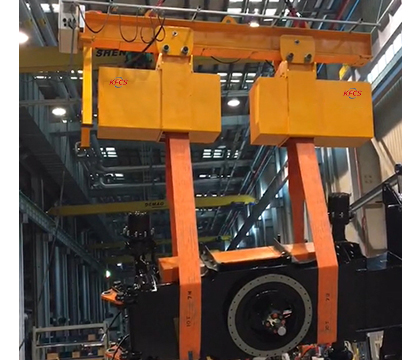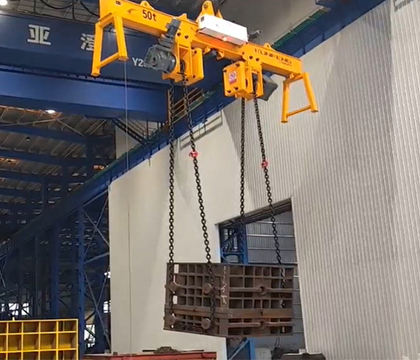
The chassis turnover machine features one beam that attach to cranes to lift and rotate long loads. Load turning device is designed to accommodate different workpiece sizes and characteristics.
The chassis turnover machine features one beam that attach to cranes to lift and rotate long loads. There are modules on both sides and modules are motorized and operate in tandem from a single radio remote handheld pendant. For loads with non-uniform circumference along the length, one module can be motorized and the other is an idler.
The structure of turnover machine is simple, the cost is low, but the work efficiency is high, and it is safe and reliable.
Requirements of Chassis Turnover Machine:
First, load turning device is designed to accommodate different workpiece sizes and characteristics. Based on the structure of each workpiece, customized fixing devices are used. Second, during the turning process, the horizontal movement of the workpiece's center of gravity is minimized, ensuring stability throughout the operation. Noise levels are kept as low as possible to prevent noise pollution, while energy consumption is reduced to meet energy-saving and emission reduction goals. Finally, the device must be capable of flipping between 0 to 360 degrees, depending on the specific turnover requirements.

Belt type turning machine
The chassis turnover machine operates by driving a turning belt to flip the chassis. This belt turning machine is primarily designed for light truck production. Its main features include:
1. The belt turning system has excellent adaptability, with suspension points mainly positioned near the front and rear axles.
2. Since the belt directly contacts the chassis, its lifespan is relatively shorter.
3. The turning process can generate significant impact, leading to higher safety risks.
4. The height of the turning machine is relatively low, positioned close to the ground.

Chain type turning machine
The chain-type turnover machine is similar to the belt-type version, but it uses a chain instead of a turning belt. Unlike the flexible belt, the chain's rigid structure can potentially damage the chassis' appearance and components. To mitigate this, protective measures are added to the chain's turning section. Currently, the chain-type turning machine is the most commonly used in major domestic heavy truck manufacturers. The turnover machine drives the chain, which is an open chain with hooks at both ends, connecting it to the turning belt for operation.
However, the chain-belt turnover machine has some limitations. The turning belt is costly and prone to significant wear. Additionally, because both the belt and chain have an open structure, the machine requires a higher ground clearance, with the turning mechanism typically positioned about 7 meters above the ground.
We understand that every workshop has unique needs. That's why our car frame load turning device can be fully customized with additional accessories and features, designed to meet your specific requirements. Whether you need different lifting capacities or specialized attachments, we offer the flexibility to create a solution that fits your business perfectly.